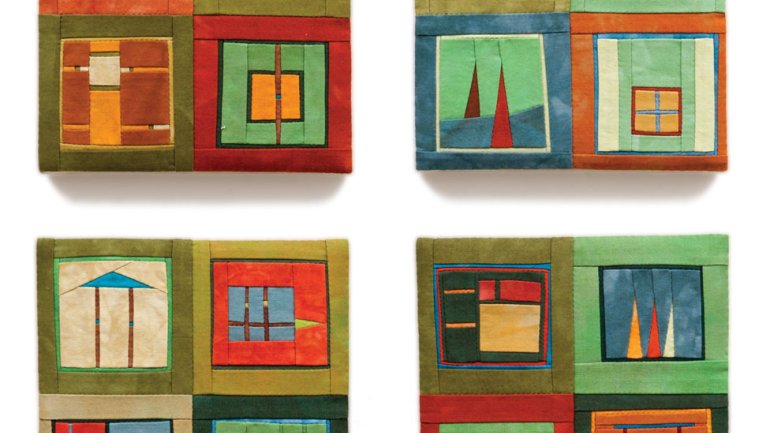The Family Way
The Family Way
Brooklyn artist Erin Wilson’s quilts radiate color. They seem to glow from top to bottom, side to side, corner to corner. Shifting saturation and hue draw the eye across the work. Geometric compositions appear in individual squares, like frames in a film, windows in a building, or snapshots of motion.
The suggestion of motion in her work is logical, perhaps, because Wilson came to quilting by an unusual path: dance. After earning her BFA in dance from Juilliard in 1998, she performed for seven years with the avant-garde David Neumann modern dance troupe before turning to her current art form full time in 2006.
Born in Indianapolis in 1977, Wilson grew up in a family of crafter role models. When she was a young child, her mother was a soft-sculpture artist on the craft-show circuit whose booth consistently sold out. Her father is an amateur woodworker. Her older brother makes amazingly complicated origami “for fun.” The house was always full of fabric and craft supplies of every description. “We just made everything in our family,” Wilson says.
When she was 8, her mother turned her creative energies to making dance wear for her daughter. Soon other dancers wanted the gear, and it was sold in the studio where Erin trained, then in a separate shop. Ultimately demand grew so much that Wilson’s father quit his job to contribute his marketing and business skills to the enterprise. The company that resulted, Motionwear, is now a premier supplier of dance wear, employing more than 100 people, all in the United States.
Just as the family’s creative drive spurred Motionwear, it gave Wilson a push into fiber art. When she was in high school, she and her mother began dabbling in dyeing. It became a passion. To this day, she says, “dyeing the fabric is pure joy. It is a never-ending process of discovery. It’s the only time I get lost. I lose track of time.” A high school summer spent working with polymer clay refined her sense of how color and shape interact – which today informs the compositions in her quilts. Then came her graduation gift when she finished at Juilliard: a sewing machine. As she advanced in her dance career, quilting remained a personal creative outlet. She continued to experiment with dyes, developing lush, nuanced colors, and cultivating her signature improvisational quilting style, in which each shape is designed at the machine, composed of narrow strips of fabric as it is sewn.
Then came a shift. After seven years of dance, she says, “I was starting to feel I had come to a wall,” she says. The realization struck: “I was done with stage performing.” At the same moment in 2005, she says, “my sewing world had blossomed.” In the kitchen of the Brooklyn apartment she shared with a roommate, she stapled felt to the wall to make a design board and set up a drop-leaf worktable her dad had made and began making quilts to show.
Show she did, and the enthusiastic response of buyers and fellow artists at the 2006 American Craft Council show in Baltimore buoyed her determination to pursue quilting full time.
Since that show, Wilson’s work has been exhibited at the New England Quilt Museum, the San Jose Museum of Quilts and Textiles, and the Schweinfurth Memorial Art Center in Auburn, New York, where she won the 2008 Juror’s Choice Award for Spice and the 2009 Best in Show for Color Story: October Red, and served as a juror herself. Her quilt Miscellany won the People’s Choice award at Quilt National 2009, hosted by the Dairy Barn Arts Center in Athens, Ohio. Her most recent work, Shape Studies, reinterprets shapes from previous color quilts on a monochrome scale, bringing the focus sharply onto the graphic aspect of her work.
Wilson may have moved a long way from dance, but her dancer’s instinct for gesture, color, and movement continues to inform her work. And just as a dancer’s performance might, Wilson’s quilts tap the viewer’s own imagination, closing the creative circle.
This is a corrected version of the story published in the October/November 2012 issue of American Craft. Rachel Schalet Crabb is a writer and fiber artist in Minneapolis.




